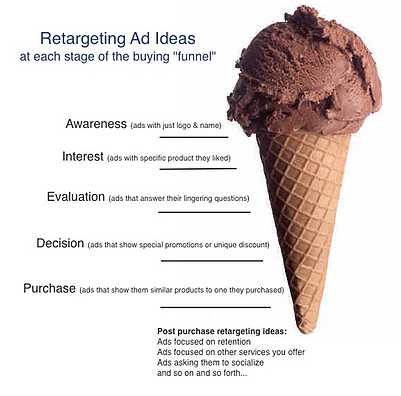Topics:
Inbound SalesSubscribe now and get the latest podcast releases delivered straight to your inbox.
 "Nothing haunts us like the things we didn't buy."
"Nothing haunts us like the things we didn't buy."
I came across this quote several nights ago while I was scrolling through my Tumblr feed and my inner-marketer had a good laugh.
We've all visited a website, took a look around, and jumped ship without buying anything or filling anything out, right?
You innocently move on to a different website, and like clockwork, the website you were just looking at appears in an advertisement.
Before you jump to conclusions, this is not some sort of Internet sorcery. It's a marketing strategy called retargeting, and 1 in 5 marketers are doing it. (Source: Chango)
Why?
Quite simply, it's working.
What is retargeting?
With only 2% of shoppers converting on the first visit to an online store, what is your business doing to bring back the other 98%?
Retargeting is a paid search marketing strategy that allows brands to stay in front of potential customers after they've bounced off their site. In the simplest terms possible, this is how it works:
.png?width=450&name=EXIT_(5).png)
Allow me to expand a bit.
Retargeting employs a bit of code (also known as a retargeting pixel), that drops a tracking cookie on a visitor's browser, making it possible for your advertisements to appear elsewhere once they've left your site.
While we're certainly not one for intrusive marketing, studies show that online consumers are actually open to receiving behaviorally retargeting ads. In fact, 60% of consumers remain neutral about the concept, while 25% actually stated that they enjoy retargeting ads because they remind them of what they were looking for. (Source: Neolane)
1. Leverage data
The most successful marketing iniatives begin with careful consideration for the consumer's wants, needs, and behaviors. This information is then analyzed and applied to campaigns in an attempt to produce the highest performing results.
If you're looking to retarget returning customer, you'll want to take a close look at their past purchases and website behaviors. This will help you build a better understanding of where their interests lie so that you can present them with advertisements that make the most sense.
For brand new visitors, you'll want to evaluate which pages they've viewed in order to determine what it is that may have been were looking for. The more data you have to work with, the better, as it becomes easier to draw conclusions based off common or reoccurring browsing patterns.
This type of strategic analysis helps you to deliver the right message, to the right person, at the right time, in an effort to carry them back to your website.
2. Segment your audience
Much like segmenting your emails to appeal to different buyer personas or stages of the sales funnel, audience segmentation for retargeting campaigns allows marketers to deliver a more tailored message based off a visitor's unique interests.
With the data uncovered, marketers can then apply that bit of code I mentioned before (also known as a retargeting pixel) to different pages through out their website so that they can adjust the display of advertisements accordingly.
While a break down of the sales funnel would suffice here, I came across this visual from Moz that I simply couldn't resist referencing (ice cream cones > sales funnels.)

Using the data you've uncovered about their behaviors, you can begin to place visitors into different buying stages like the ones outlined above. Seeing as though the interests and needs will vary based on their level of readiness, the advertisements you select should reflect just that.
While simple advertisements with just your business' logo are effective for visitors in the "Awareness" stage, returning customers are more likely to find value in advertisements that reflect their past purchases.
3. Conduct A/B tests
When it comes to effective retargeting, you never want to allow uncertainty to influence your decision-making. Rather than pour time and resources into a campaign rooted in gut instinct, consider conducting an A/B test to uncover what's really working, and what's not.
Here are 2 ways that you can use A/B testing to improve the performance of your retargeting advertisements:
1. Determine a schedule for rotation
After 5 months of running the same advertisements, ReTargeter found that clickthrough rates had decreased by almost 50%. To ensure that the advertisements that you're running aren't losing their effectiveness, you'll want to have a new wave of creative to add to the rotation.
While ReTargeter noticed a decline after 5 months, every business is different. We suggest that you pay close attention to the performance of the advertisements over time to determine the best time to switch out the old and input the new.
2. Experiment with different copy
The fact that there is limited room for copy on retargeting ads makes the copy that you do employ that much more important.
While the copy you have in place right now might be driving positive results, you won't know if there is an even better option unless you test it out.
Just keep in mind that if you're testing copy, you'll want to keep every other aspect of the advertisement the same (color, size, placement.) The reason being, too many variables will make it impossible to determine whether or not the variation of copy was influential, or if the performance was swayed by other factors.
Has your company experimented with retargeting? Did it work? Feel free to share your experiences below. We'd love to hear what you think...


Order Your Copy of Marcus Sheridan's New Book — Endless Customers!

